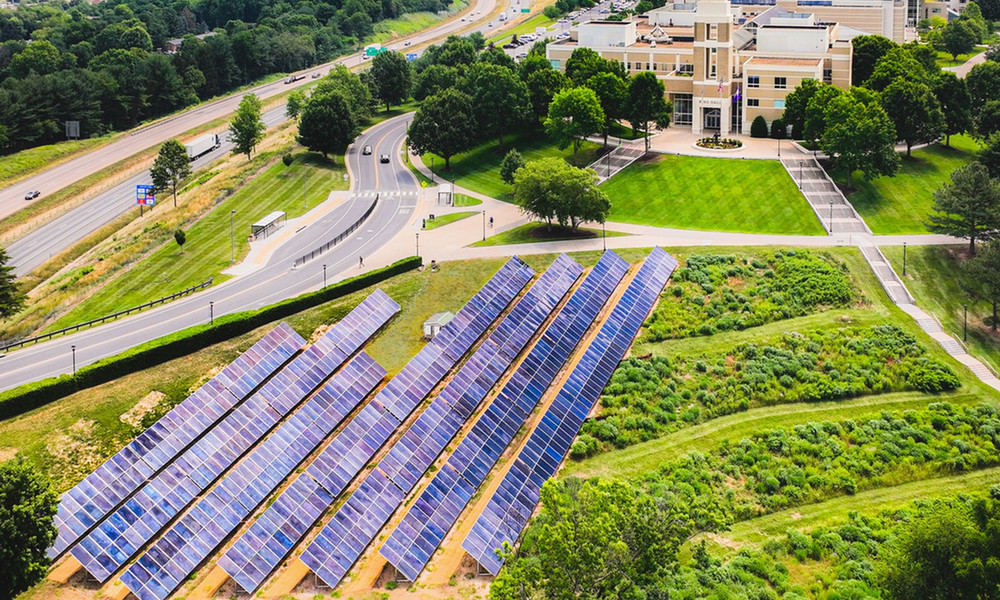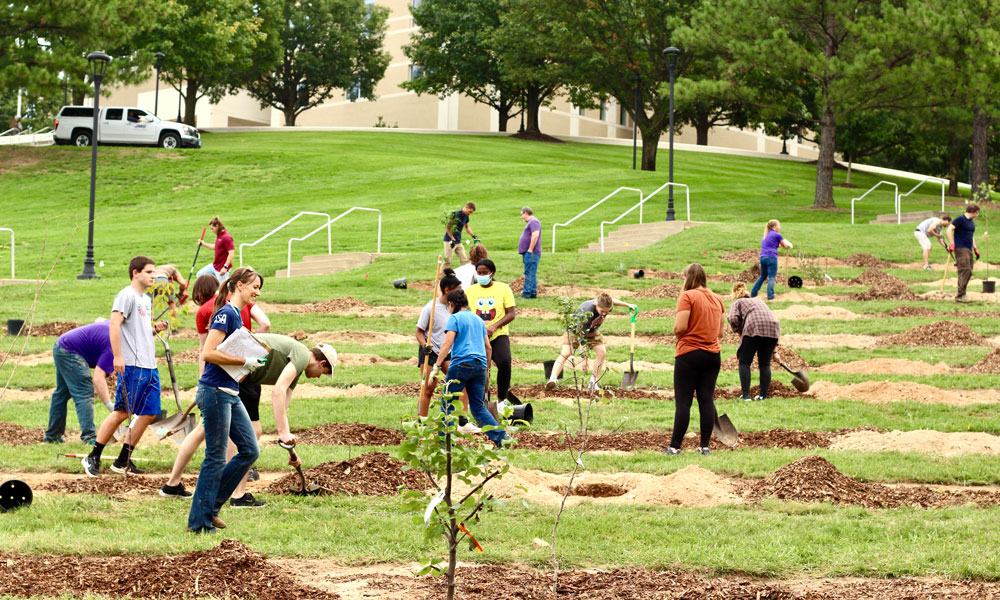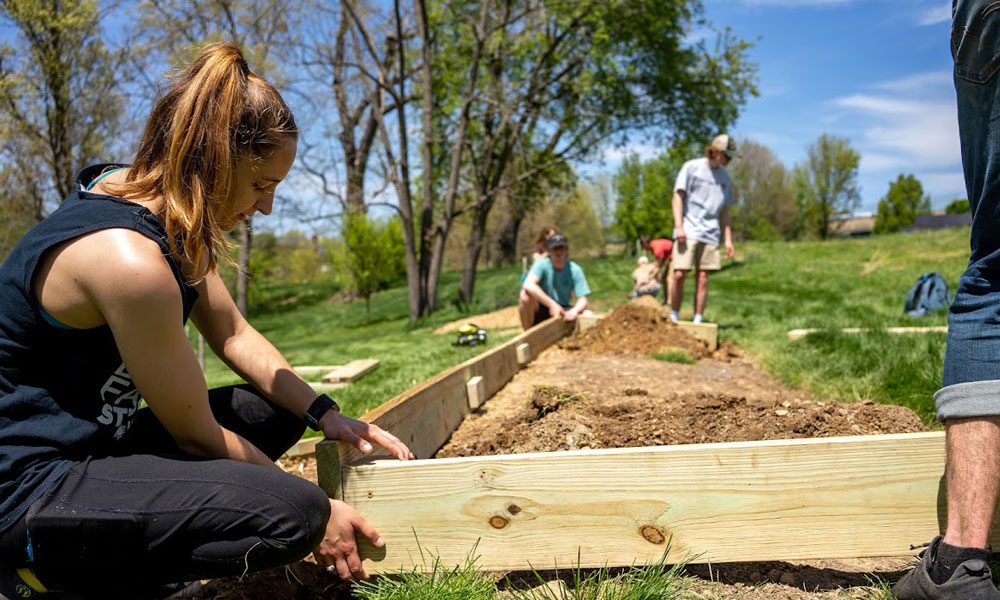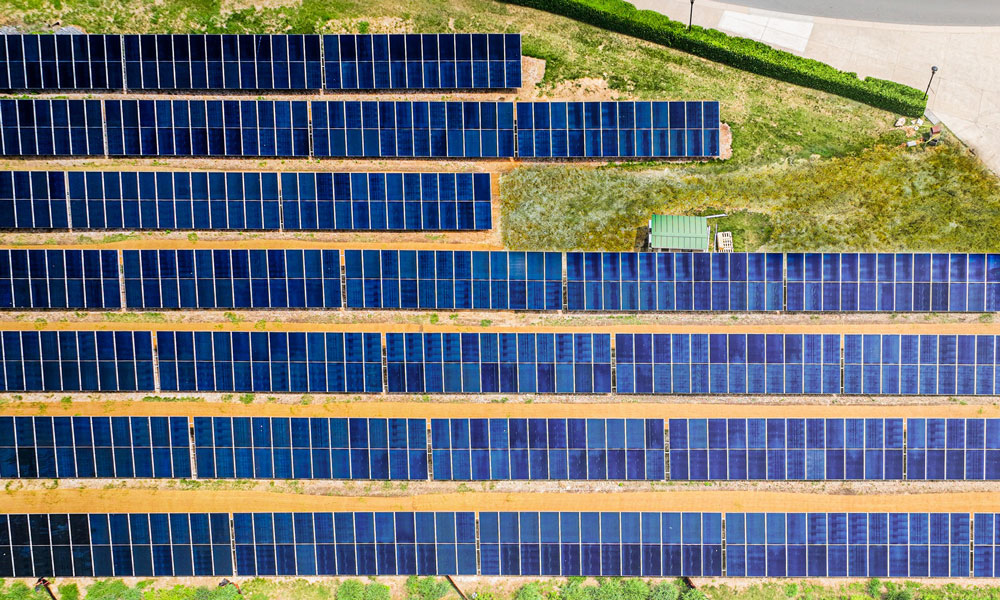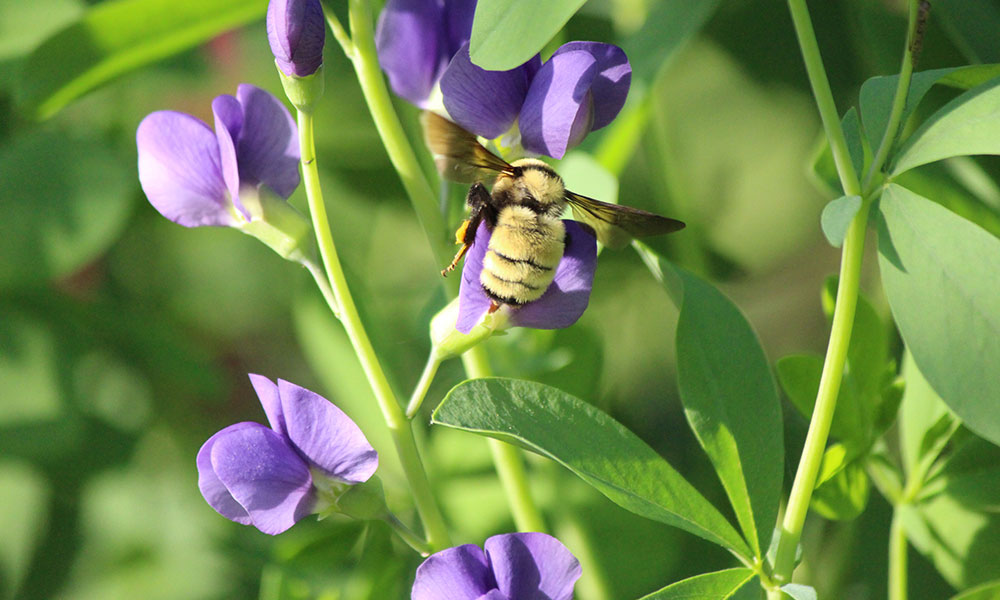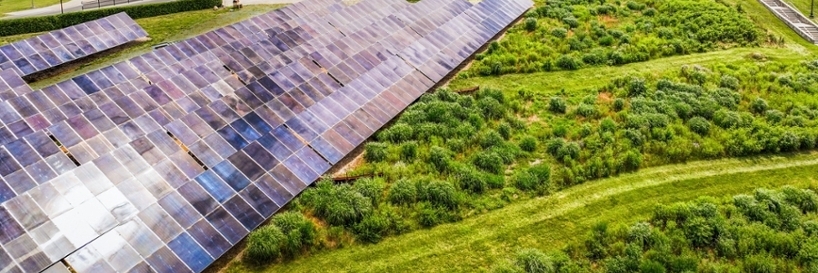
EAST CAMPUS HILLSIDE
The East Campus Hillside is location 7 on the tour and also appears on the Story Map.
The East Campus Hillside has a long history of human-environment interaction. 4,500 years ago, Indigenous families ancestral to the Monacan Nation camped along the stream at the base of the hill. From forest, to agricultural field, to pasture, the landscape has seen much change. In more recent years, a traditionally manicured grass area has been transformed into an outdoor educational ecosystem that provides students and faculty with an outdoor learning resource and demonstrates JMU's commitment to environmental stewardship. Collaboratively developed by JMU faculty, students, staff, community members, and a Visiting Scholar, the project won a silver-level Governor's Environmental Excellence Award in 2014.
The East Campus Hillside Project, located below King Hall, began in 2010 with an educational meadow designed in cooperation with students, faculty, staff, and a visiting scholar. Now a six-acre area that advances student education, environmental quality, and campus sustainability, the hillside supports student learning outcomes and brings positive attention to the university through funding, recognition, and replication. The hillside features three acres of meadows containing primarily native plant species, a two-acre tree planting area home to 25 different tree species, 1031 feet of restored stream channel and associated riparian buffer, a solar array with pollinator habitat, raised beds, a weather station, and a 0.5-acre food forest. The hillside supports engaged learning through place-based, hands-on integration with curriculum across multiple academic areas including Biology, Geography, Geology, Integrated Science and Technology, and Interdisciplinary Liberal Studies. More than thirty-two sections of nineteen courses used the hillside in recent years.
The project has greatly contributed to environmental sustainability, addressing the triple planetary crises - biodiversity loss, pollution, and climate change - identified as part of the United Nation’s Sustainable Development Goals. Numerous environmental benefits are achieved by the project.
- The hillside meadows' native plants and trees provide wildlife habitat on campus.
- The replacement of traditional fescue grass by the meadows reduces the potential for pollutant runoff into the stream channel from traditional turf management practices.
- The restored stream channel and associated riparian buffer provide downstream water quality benefits to Blacks Run, the Shenandoah River, and Chespeake. As part of JMU’s compliance with the Chesapeake Bay Total Maximum Daily Load Action (TMDL), the pollutant removal due to replacement of turfgrass by the meadow is 4.81 lbs/ac/yr nitrogen and 1.21 lbs/ac/yr phosphorus each year. JMU Facilities Management produces a photo-filled annual report about all of our TMDL reductions, stormwater education and outreach, and more.
- The extensive educational use of the hillside was a key factor in the decision to implement more sustainable landscape approaches for the JMU land bridge. The forest/open space meadow in that area was increased to a total of 4 acres and meets stormwater management runoff reduction requirements.
PHOTOS
SUSTAINABILITY FEATURES
When visiting in person, follow the numbered trail markers to learn more about ten features in the hillside area.
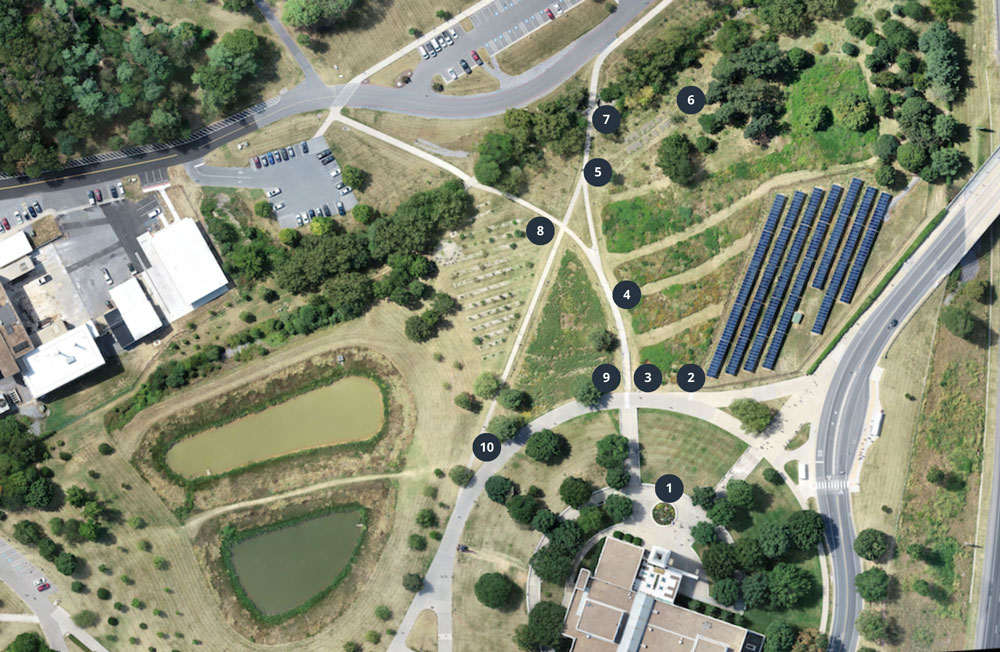
(1) A statue of President James Madison marks the start of the short walking tour of the hillside. JMU’s environmental stewardship initiative is following the environmental tradition of our university’s namesake. President James Madison, Father of the Constitution, has been identified by Author Andrea Wulf as “the forgotten father of American environmentalism” (Smithsonian Magazine, 2011). According to Wulf, “President Madison tried to rally Americans to stop destroying the forest and the soil. He said for America to survive, Americans had to protect their environment. He did not romanticize nature as later generations did. President Madison looked at this in a practical way, saying nature was a fragile ecological system, and if people wanted to live off nature, in the long term something had to change.” Fast forwarding from past to present, our environmental work at JMU recognizes the natural world’s intrinsic value, as well as the fact that human prosperity and environmental quality are inextricably intertwined. Accordingly, we are committed to contributing, as individuals and as an institution, to human and ecological health. We encourage everyone to consider how environmental stewardship is and can be integrated in our lives, including through civic engagement, engaged learning, and community engagement.
(2) Over the summer in 2022, a 310 kW solar array was installed on the East Campus Hillside of the university and connected to King Hall. The project builds on the experience from the JMU Center for the Advancement of Sustainable Energy's previous 10 kW solar array. The replacement and expansion of the old solar photovoltaic system, as recommended by the JMU Clean Energy Working Group, was funded in part by the Virginia Department of Energy. The array includes pollinator habitat. Some of the original hillside meadow was removed and other parts disturbed by the expansion of the array. A new meadow was planted between the panels and around the expanded array to achieve shorter plant heights that would not shade the panels. Some species planted were recommended by the faculty, and some shade tolerant plants were selected that were beneficial to pollinators based on the Solar Site Native Plant Finder tool on the Virginia Department of Conservation and Recreation’s Pollinator-Smart website. Bird house, bee nest shelters, and educational signs were installed on a fence around the array. This site received certification in 2023 as a Virginia Pollinator-Smart Solar Site. JMU was the first university to receive this certification.
(3) This is the Upland Meadow, which was the first phase of the hillside project in 2010 and provides wildlife habitat on campus. The replacement of traditional fescue grass by the meadow reduces the potential for pollutant runoff into the stream channel from traditional turf management practices. It also reduces the potential for erosion from the hillside meadow by establishing deep rooted vegetation. Additionally, the naturalized landscape was planted in multiple strips along the contour to provide an example of the common practice in conservation agriculture of contour farming. Scholar-In Residence Michael Singer facilitated the design of the meadow portion of the project- an idea that originated from a professor in the department of Integrated Science and Technology. Students (as part of their courses and capstone projects) worked with faculty to contribute to the overall vision and the design of the meadow. This meadow won a silver-level Virginia Governor's Environmental Excellence Award in 2014.
(4) A weather station overseen by the JMU Geography Program provides data for use by courses.
(5) Raised beds are used for student class and research projects that focus on biodiversity and agricultural topics. The work supports pollinator efforts on campus and JMU’s Bee Campus USA affiliation.
(6) The Tree Education Area contains 2 of each of the 25 tree species planted. The trees were selected based on aesthetics and screening as well as usefulness for education. Many trees are native and included overstory hardwoods, understory hardwoods, and gymnosperms. A number of species of trees not commonly found elsewhere on campus were included in this area to help promote the biodiversity of trees on campus. The Trees of James Madison University project provides a walking tour of the diversity of trees on the campus, including maps and information on each tree species.
(7) The restored stream channel and associated riparian buffer provide valuable protection for the nearly 600 acre urbanized watershed that drains to this area. The stream restorations were funded in part by a National Fish and Wildlife Foundation grant, "Community Solutions to Stormwater Pollution in Blacks Run," awarded to a community partnership which included JMU Facilities Management. The case study describes the partnerships and outcomes from the stream restoration project.
(8) The food forest, also referred to as the JMU Edible Forest Garden (EFG), is a 0.5-acre area planted with fruit trees, nitrogen fixing trees, fruiting shrubs, and herbaceous plants. The first phase in October 2021 involved planting over 100 trees and shrubs in a trios design - alternating fruit trees and nitrogen fixers. More than 20 species were planted, and the vast majority of the trees were dwarf and semi-dwarf varieties that will produce a variety of common fruits (apples, peaches, pears) and lesser-known fruits (persimmons, jostaberries, goumi). The second phase is ongoing and involves planting the herbaceous and ground cover layers. Adjacent to the rowed food forest area is a space with tree-stump seating for approximately 20 students.
(9) This steep, triangle-shaped section of land bordered by three sidewalks was planted with a mixture of annual and perennial flowers and grasses in summer 2023. This land has a steeper slope and greater variety of blooming plants and grasses than the original Upland Meadow mix. This section of the hillside followed expansion of the solar array, which displaced one-third of the original Upland Meadow. While Facilities Management planted a shade-tolerant meadow mix around the expanded solar array, faculty also recognized the value of the original meadow plants for education. This triangle-shaped area was planted to maintain significant meadow coverage on the hillside and provides for the comparison of ecological processes that take place between it, the Upland Meadow, and the Solar Pollinator-Smart Meadow. This project was one of the top recipients of Madison Trust funding in 2022.
A bench is provided at this site to sit and enjoy the hillside. The bench was partially funded with an award from The American Association of Geographers (AAG) to the JMU Geography Program as one of two recipients of the 2021 Award for Bachelors' Program Excellence in Geography.
(10) There are many stormwater Best Management Practices (BMPs) on the JMU campus, and these retention ponds are one example. Some BMPs are designed to deal with water quantity and store stormwater run-off and release at a slower rate to reduce downstream flooding and erosion, while others are designed more for water quality and filter potential pollutants that drain through the practice. And then there are some BMPs that do both. Detention, or dry ponds, are constructed to provide general flood protection, collecting stormwater run-off and releasing it down stream at a slower rate, helping limit flooding downstream. There are eleven detention ponds located on JMU’s campus. Retention, or wet ponds, like the ones on the hillside, work very similarly to dry ponds except retention ponds will have a permanent pool of water. You will see “No Mow” signs around JMU’s retention ponds indicating that limited mowing is part of the best practice. Learn more about the various stormwater BMPs that can be found on JMU’s campus using Facilities Management’s Stormwater BMP map.
STUDIES
Developing a Natural Educational Landscape on Campus Grounds, Christie-Joy B. Hartman, Wayne Teel, Amy Goodall, and Carole Nash, Smart and Sustainable Campuses Conference, Baltimore, MD, March 30-31, 2015
ENGAGED COURSES AND STUDENT PROJECTS
For more information about each course below, search by course number in the Undergraduate Catalog.
- BIO 366: Environmental Ecology and Evolution
- BIO426: Topics in Biology
- GEOL 497: Problems in Geology
- GEOG 200: Global Dimension
- GEOG 210: Physical Geography
- GEOG 308 Environment, Nature, and Society
- GEOG 315: Field Methods in Geography
- GEOG 322: Agricultural Systems
- GEOG 327: Climatology
- GEOG 340: Biogeography
- GEOG 415: Environment, Landscape, and Culture
- GEOG 440: Advanced Biogeography
- GEOG 470/ISAT 480: Citizen Science
- ISAT 100: Environmental and Energy Sustainability
- ISAT 112: Environmental Issues in Science and Technology
- ISAT 160: Problem Solving Approaches in Science and Technology
- ISAT 320: Fundamentals of Environmental Science and Technology I
- ISAT 424: Natural Resource Management
- ISAT 425: Environmental Hydrology
- ISAT 429: Sustainability: An Ecological Perspective
- ISAT 480: Energy in the Living System
- ISCI 173: Life and Environmental Science for Teachers
Example Courses:
ISAT 320: Fundamentals of Environmental Science
Learning Objectives:
- Identify plant species and populations
- Execute proper field techniques for soil collection and preparation for storage and analysis
- Articulate fundamental soil properties
GEOG 470: Geographic Science Senior Seminar, Global Biodiversity
Learning Objectives:
- Explain the importance of expertise for identification of species
- Describe how biodiversity of butterfly species is measured
- Explain how expertise influences knowledge of global biodiversity
- Develop a guide to butterflies
GEOG 390-490-495: Senior Capstone
Learning objectives:
- Supply the university with a keyed guide for plant identification for future use
- Create a baseline of the meadow’s development through transect survey of vegetation
- Analyze vegetation distribution based on recommendations outlined by the Society for Ecological Restoration International Primer
In addition to use by specific courses, at least a dozen student capstone projects have utilized the hillside. For example, a year after the meadow was planted, a student group estimated the density and distribution of plant species in the meadow and created a keyed identification guide. Building on this work, a student examined the relationship between the distribution and abundance of plant species in the meadow and soil conditions, elevation, and hydrology. Further work on soils produced a soil health analysis and an experimental study on composting as a method for increasing carbon storage in soils. Seven Geography capstone projects have measured the abundance and biodiversity of butterflies at field sites in Harrisonburg, Virginia, including the hillside.
Example Projects:
Compost Land Management and Soil Carbon Sequestration, Kylene Hohman, Advisor: Dr. Wayne Teel, Department of Integrated Science and Technology, ISAT Capstone Project, April 2016
The Biochar Impacts on Soil Nutrient and Carbon Content in the ISAT Meadow, Johnathan Brittell & Grant Rabalais, Advisor: Wayne Teel, Department of Integrated Science and Technology, ISAT Capstone Project, 2019.
Temporal and Spatial Patterns of Butterfly Diversity and Abundance in Harrisonburg, Virginia, Dr. Amy Goodall, Chase Briles, Patrick Cuccias, Bayan Waters. International Urban Wildlife Conference, Washington D.C. June, 2023. (International Urban Wildlife Conference Program, page 17).
RECOGNITION
2014 Silver-level Governor's Environmental Excellence Award
2023 JMU President's Purple Star Award for Academic Quality- Transcending Boundaries


